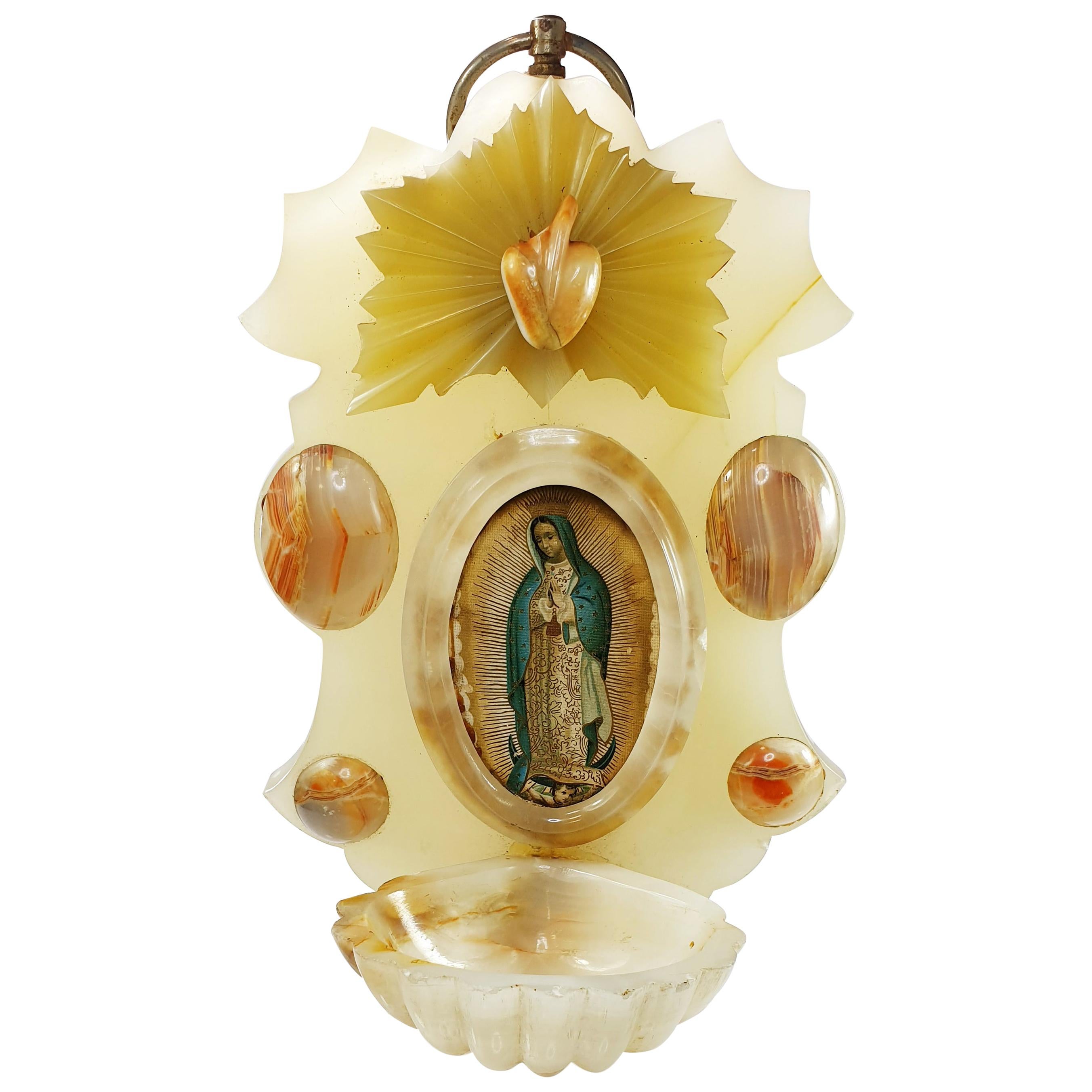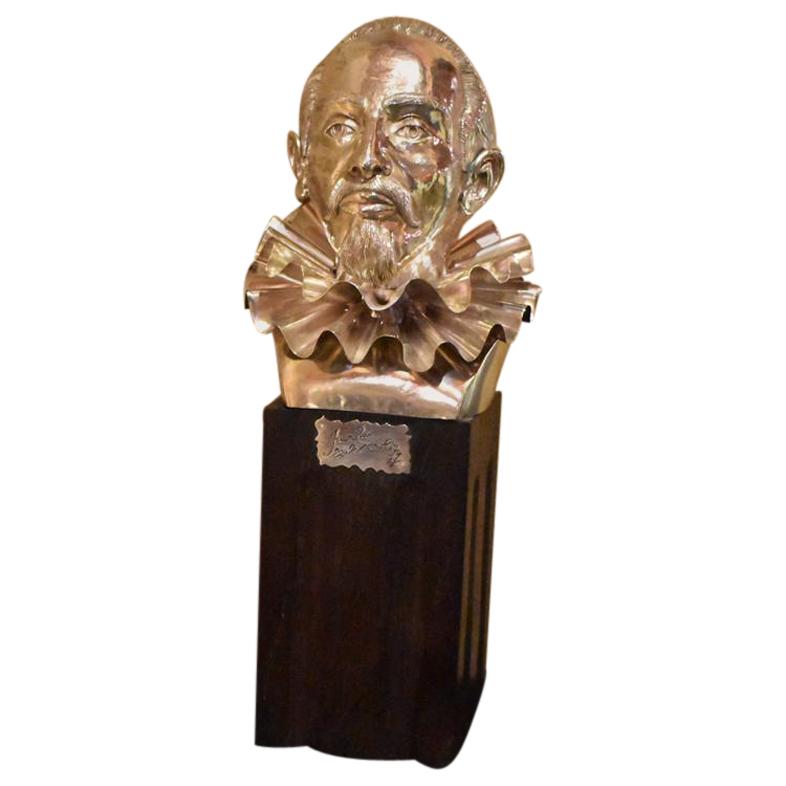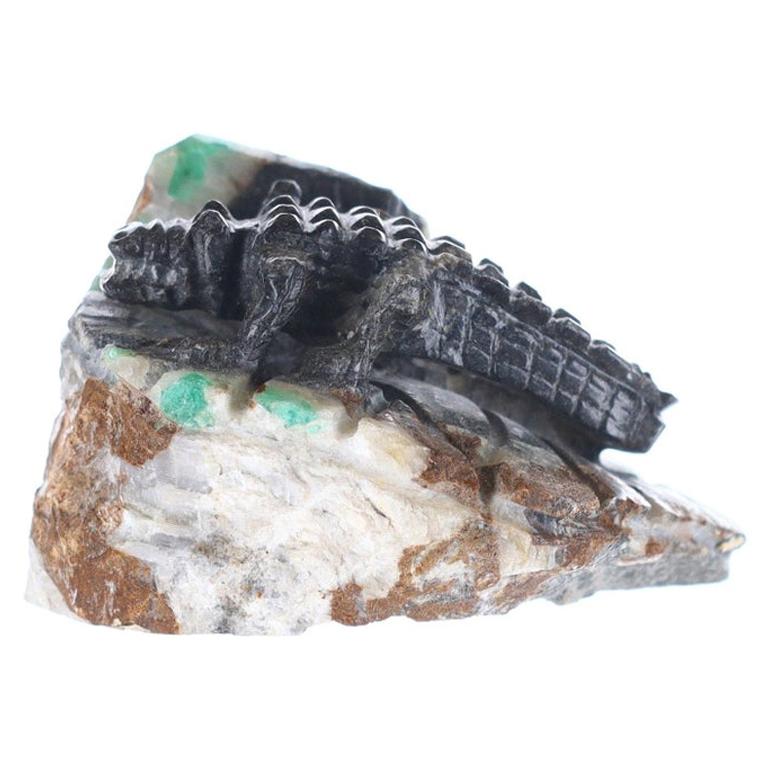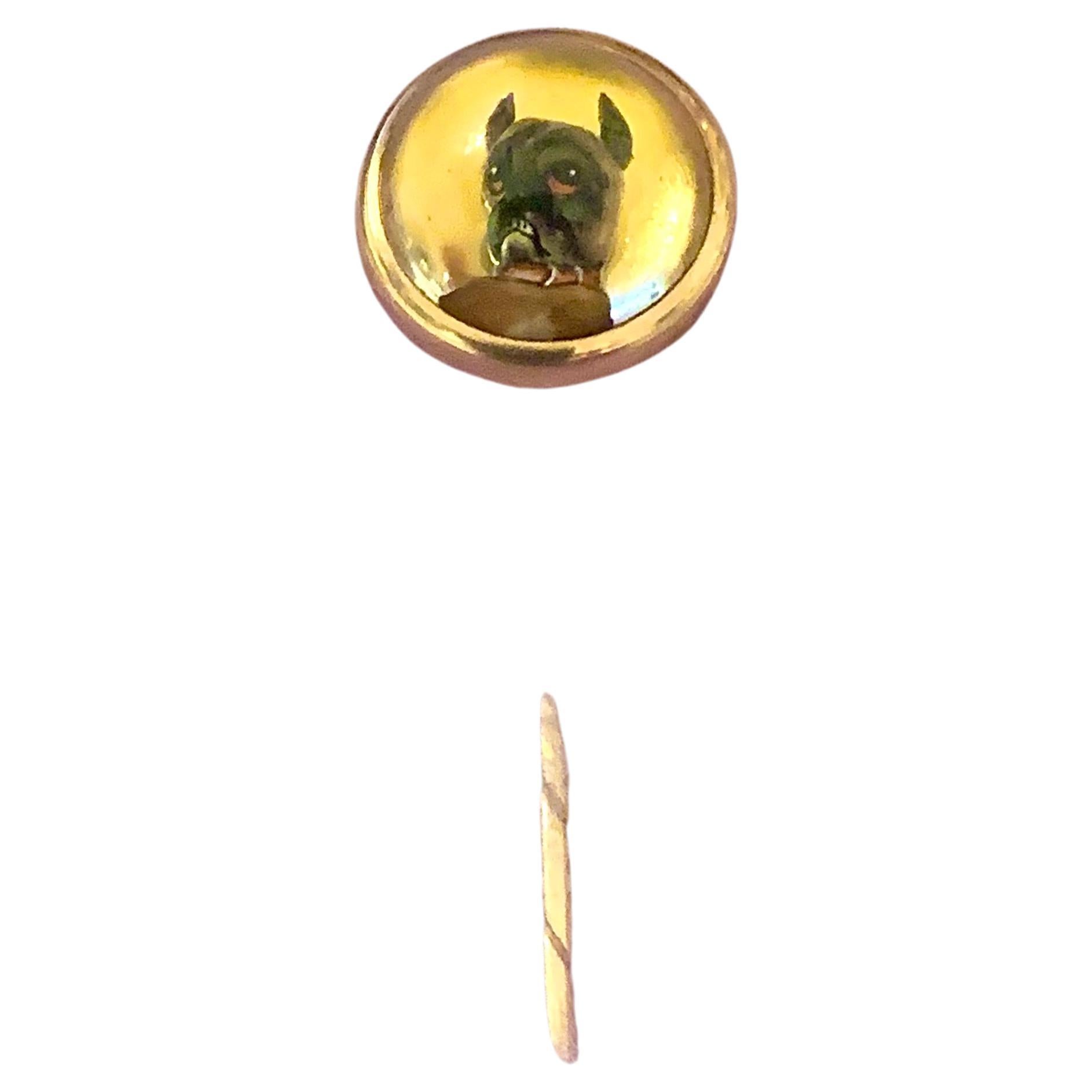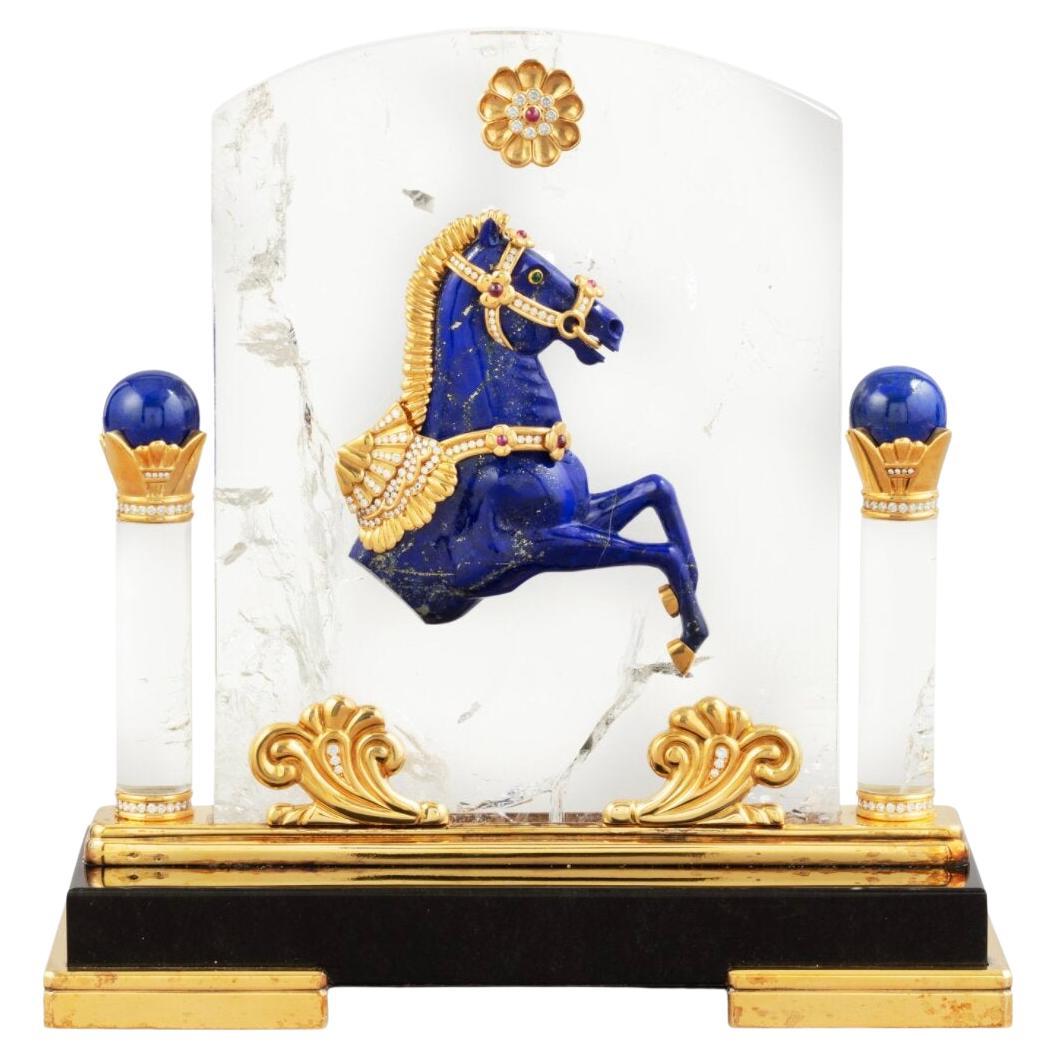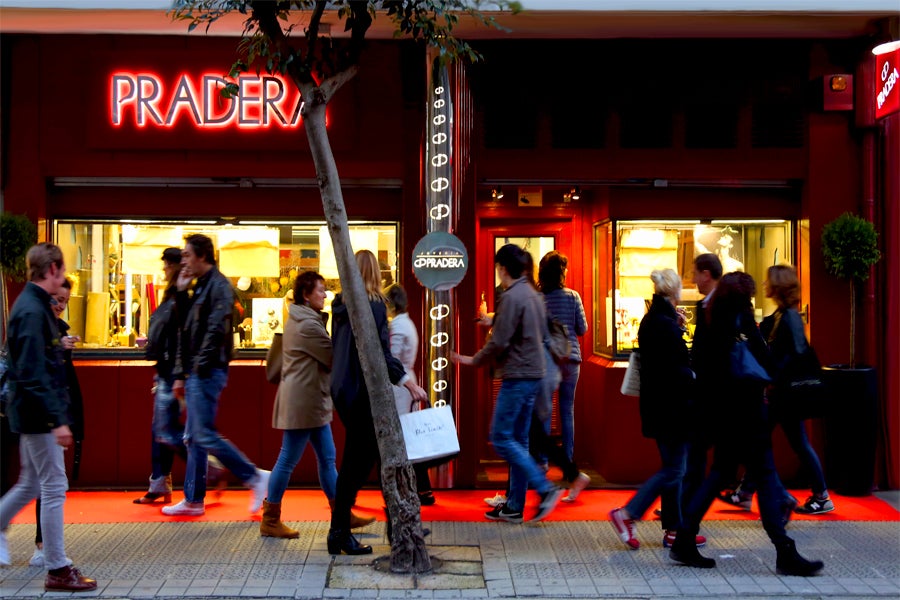Items Similar to Globe De Mariée, Marriage Crystal Dome 1880s with Love Angel
Want more images or videos?
Request additional images or videos from the seller
1 of 10
Globe De Mariée, Marriage Crystal Dome 1880s with Love Angel
About the Item
1880´s An antique French Wedding Globe or Globe de Mariée
Made for a Spanish client because it has a love angel with AMOR on it side.
These are the most special display pieces for a married couple to mark the occasion of their wedding and life together.
Over the years symbols, such as flowers from the wedding bouquet, lock of hair from their children and jewelery would be placed and protected on these stunning keepsakes.
The globes originated in France in the late 1800's through the early 1900's. After being crafted of thin metal and then covered in a ormolu (the gold overlay) and sculpted by a jeweler, each globe would be unique to the couple but most had birds, mirrors and a velvet covered "seat" to hold personal items. The velvet was usually pink and red but blue and gold were also popular choices, and original wax flowers and golden.
Usually this has a glass dome over it to protect it from dust and wind and breakage but as the globes are very fragile, many were broken and you often find them minus the glass globe just like this one. This one is original and is intact.
You can add anything to this to make it your own. Great to dispaly your jewelry on it or a bedroom focal piece or on a vanity to showcase my favourite jewellery pieces!
The tradition of Globe de Mariée Display pieces began in France, in the 1800′s. It was a display for married couples, to preserve their wedding souvenirs as well as tell the story of their wedding & life together. Placed prominently in the formal dining room, it held the Bride’s Crown, or Bridal Tiara made from fresh or wax Orange Blossoms, at times her Wax Floral Bouquet.
The bride & groom chose items for their personalized display such as mirrors, porcelain pieces, and ormolu {gold plated}cut-outs. Each had a special and very personal meaning to them, it was a symbol that told the story of the bridal couple. The number of small diamond-shaped mirrors represented the number of children the couple hoped for.Over the years special items were added, photographs, little locks of their babies hair, jewelry, more ormolu symbols.
Each was carefully pinned to the velvet or silk cushion, most of the cushions were Red, although Pink, Blue and Gold were also produced.
During the height of their popularity in the Napoleon III era, there were many ready-made bases couples could pick from, then add their choice of gilded symbols, mirrors, porcelain flowers, and other gilt decorations, making each one of these highly personal, and unique. After all the ormolu pieces were attached by the jeweler, the display piece was covered with a very fine, thin and handblown dome.Each symbol had meaning:
The Bird: The symbol of Love and protection
Leaves: Longevity of the Marriage Union.
Orange Blossoms: Virginity.
Roses: for eternal love.
Daisies: for purity and innocence.
Ivy Leaves: commitment to each other.
Lime Leaves: symbolized fidelity.
Oak Leaves: for strength and longevity of the couple.
Chestnut Leaves: for links to others.
Fig Leaves: for prosperity.
The tree: a symbol of love and strength.
Four Leaf Clover: Good Fortune {luck}
Sheaves of Wheat: fertility, and also to the resurrection of life.
Cherries: for protection against bad fortune.
Clusters of Grapes: prosperity.
The Dove: symbolized the desire for peace in the home.
The Bird holding a laurel wreath: symbolized that as a bird makes its nest, so does the woman build her family.
Each mirror had meaning:
The central {largest} mirror evoked the reflection of the soul, symbolizing the truth.
Rectangular mirrors were related to the number of years between the couple’s meeting and their promised marriage.
The oval mirrors were good luck gifts offered by the bridesmaids.
The number of small diamond-shaped mirrors represented the number of children the couple wished for.
The trapezoidal mirror symbolized the perfect agreement.
They are most rare pieces of history. To get your hands on one is difficult, especially one with the glass dome intact.
A true find! They are little treasure boxes of love and history wrapped in a beautiful package, it is as romantic and unique piece of art, history and jewelry.
You will LOVE it!
Measurements:
Height 23cm /9,05in
Depth 16cm/ 6,29in
*Shipment of this piece is not affected by COVID-19. Orders welcome!
PRADERA is a second generation of a family run business jewelers of reference in Spain, with a rich track record being official distributers of prime European jewelry brands like Chanel, Baccarat, Pomellato, Mattioli, Chantecler, Valente, Breitling, Audemars Piguet, Fabergé ... they have a large experience from working and observing best European craftsmen, best jewelry techniques and practices, and they have curated jewelry collections for high net worth individuals and family heritages.
IRAMA PRADERA the creative director of design and estate department has a "Multinational Management degree for Wharton Business School" at the University of Pennsylvania and a "Diamond and Colored gem Grading" form the GIA in NY, she has worked for main auction houses in Jewelry department in Christie´s in NY, and in Real State and Interior Design division for Sotheby´s Int. Realty in Madrid and Marbella.
All PRADERA jewels are guaranteed and come from sustainable and reliable sources and owners. We are 360º company with passion for jewelry and the value of time, gold and precious stones, PRADERA is dedicated to bring sparks of unique lives and tell stories of the beautiful things made with love and lived with joy.
- Metal:
- Stone:
- Stone Cut:
- Style:
- Place of Origin:
- Period:
- Date of Manufacture:1880
- Condition:Wear consistent with age and use.
- Seller Location:Bilbao, ES
- Reference Number:1stDibs: LU1204310780052
Joyeria Pradera
Pradera is a renowned jewelry brand born in Bilbao, Spain in 1976 who over the years has developed a wide range of clients in other bases as Marbella and Madrid. Their jewels creations are rich in color and textures, always working with the best craftsmen and precious gems. They have been the official distributers of prime European jewelry and watch brands like Chanel, Baccarat, Bulgari, Pomellato, Mattioli, Chantecler, Valente, Breitling, Audemars Piguet, Fabergé ... The actual business is run by Irama Pradera second generation that acts as creative director with young and fresh jewelry creations and leads a selective estate department with beautiful and precious jewels from many private collectors and boutique sample pieces, she travels all over Europe, selecting the best and most beautiful pieces for a sportive and wearable nowadays look
About the Seller
4.9
Platinum Seller
These expertly vetted sellers are 1stDibs' most experienced sellers and are rated highest by our customers.
Established in 1972
1stDibs seller since 2018
234 sales on 1stDibs
Typical response time: 2 hours
- ShippingRetrieving quote...Ships From: Bilbao, Spain
- Return PolicyA return for this item may be initiated within 3 days of delivery.
More From This SellerView All
- Holy Water Font with Lady of Guadalupe and Angel in Green Alabaster and AgateLocated in Bilbao, ES1920´s Holy Water Font with Lady of Guadalupe and angel in light green alabaster and agate with a beautiful translucent quality and the many colors that can be achieved from this special stone...Category
Antique Late 19th Century Mexican Artisan Figurines and Sculptures
MaterialsAgate
- Holy Water Font with Lady of Guadalupe and Angel in Green Alabaster and AgateLocated in Bilbao, ES1920´s Holy Water Font with Lady of Guadalupe and angel in light green alabaster and agate with a beautiful translucent quality and the many colors that can be achieved from this special stone...Category
Antique Late 19th Century Mexican Artisan Figurines and Sculptures
MaterialsAgate
- Object d’Art Brass Pomellato KingBy PomellatoLocated in Bilbao, ESA window display Pomellato King Original and authentical a 13mm Brass King from Pomellato merchandising and window display actually 4 in stock In original Packaging Established 43 years ago in the Italian city of Milan, Pomellato has been forging its own meticulous path in jewelry making for many years. Having started life as a chain maker, the distinctive chain design still appears in every collection, albeit in ever more luxurious and bejeweled forms. From the iconic Nudo collection and its almost infinite combination of stackable rings to the colorful Capri collection, Pomellato jewelry...Category
20th Century Italian Contemporary Figurines and Sculptures
MaterialsBrass
- Rosary in Yellow Gold with Faceted Crystal and Cross in white gold and diamondsLocated in Bilbao, ESRosary in yellow gold with faceted crystal beads, a medal with an angel and an openwork cross in gold with diamonds, on views of white gold Length to the medal...Category
21st Century and Contemporary Spanish Artist Figurines and Sculptures
MaterialsCrystal, Gold, 18k Gold, Yellow Gold
- 18 Karat Gold Salvador Dalí Cristo De San Juan De La Cruz Necklace and BraceletBy Salvador DalíLocated in Bilbao, ESLimited Edition 18k Yellow Gold Salvador Dali Christ Saint John On The Cross Pendant Necklace / Bracelet This is a limited edition numbered piece from 1970's, number 108 out of 1000 ever made. This necklace comes with a pouch and a frame for collectors piece exhibit Accompanying card from Exmundart Original rights from Land Spring Enginering Ltd, propietor of the exclusive world-wide rights on this sculpture-jewel as stated in the document ordained by Salvador Dalí, and legalised by Mr. José Gómez de la Serna, Notary of Barcelona Spain. Details: Sculpture-Jewel cast wit the use of the lost wax process and denominated Cristo de San Juan de la Cruz Length: Necklace 25" (or 17" if wearing bracelet) Bracelet: 8" You can add bracelet to the necklace. Length: Bracelet 8¨"/ 20,32cm Necklace alone 17" / 43,18cm Necklace with bracelet...Category
Vintage 1970s Spanish Figurines and Sculptures
MaterialsGold, 18k Gold, Yellow Gold
- 18 Karat Gold Salvador Dalí Cristo De San Juan De La Cruz Necklace and BraceletBy Salvador DalíLocated in Bilbao, ESLimited Edition 18k Yellow Gold Salvador Dali Christ Saint John On The Cross Pendant Necklace / Bracelet This is a limited edition numbered piece from 1970's, number 108 out of 1000 ever made. This necklace comes with a pouch and a frame for collectors piece exhibit Accompanying card from Exmundart Original rights from Land Spring Enginering Ltd, propietor of the exclusive world-wide rights on this sculpture-jewel as stated in the document ordained by Salvador Dalí, and legalised by Mr. José Gómez de la Serna, Notary of Barcelona Spain. Details: Sculpture-Jewel cast wit the use of the lost wax process and denominated Cristo de San Juan de la Cruz Length: Necklace 25" (or 17" if wearing bracelet) Bracelet: 8" You can add bracelet to the necklace. Length: Bracelet 8¨"/ 20,32cm Necklace alone 17" / 43,18cm Necklace with bracelet...Category
Vintage 1970s Spanish Figurines and Sculptures
Materials18k Gold, Yellow Gold
You May Also Like
- Juan Ruiz De AlarcónBy Antoñio PinedaLocated in Taxco de Alarcon, GuerreroModeling the face of Don Juan Ruiz De Alarcón was finished in two pieces, with a rosewood base. Technique: chiseling and embossing. Made for the inauguration of the first Alarconian ...Category
Vintage 1980s Mexican Arts and Crafts Figurines and Sculptures
MaterialsSterling Silver
- Colombian Emerald Alligator Rough Crystal SculptureLocated in Jupiter, FLThis is a beautiful and one-of-a-kind rough Colombian emerald alligator sculpture. Hand-carved, and made of black shale, calcite, ambrosia, and natural Colombian emerald rough crystals...Category
2010s Colombian Figurines and Sculptures
- Antique Reverse Crystal Stickpin Tiepin Boxer Dog 14kt Red Gold Red Dog CollarLocated in Munich, BavariaThis reverse crystal of a boxer dog wearing a red dog collar has been hand carved and hand painted in the last quarter of the 19th century. The crystal is mounted in a red gold setti...Category
Antique 1890s Austrian Victorian Figurines and Sculptures
MaterialsCrystal, 14k Gold
- Mellerio Paris, a French Gold, Diamond, Silver-Gilt, Rock-Crystal, & Lapis HorseBy Mellerio ParisLocated in New York, NYMellerio Paris, A French Gold, Diamond, Silver-Gilt, Rock-Crystal, Obsidian & Lapis Horse An extremely rare and unique, one of a kind French gold, diamonds, Silver-gilt rock-crystal, obsidian and lapis lazuli jeweled sculpture "Bucéphale, Chevaux de légende", "Bucephalus, A Legendary Horse" by Mellerio, Paris, circa 1998. Sitting on black obsidian base, the solid rock crystal slab is finely applied with a lapis lazuli half-horse with harness mounted in 18k gold and brilliant cut diamonds, between two crystal and lapis lazuli columns adorned with gold and diamonds, insert with 7 ruby cabochons and 1 emerald cabochon, the obsidian base with a plaque engraved: CHEVAUX DE LEGENDE / MELLERIO DITS MELLER / PARIS / 5029 DIV Bucephalus (c355-326 BC) is among the most famous horses in history, and it was said that this he could not be tamed. The young Alexander the Great, of course, tamed him – and went on to ride his beloved equine companion for many years and into many battles. The piece is in excellent condition and comes with a custom made wood case made for transport. It's very elegant and has French hallmarks throughout. A truly magnificent piece. Measures 10" high x 9" wide x 4" deep Founded in France in 1613 by the descendants of Italian immigrants from the Vigezzo Valley in the north of Italy, Mellerio is one of the oldest jewellery houses in Europe. The family business soon attracted the attention of the Royal Court and Marie Antoinette herself reportedly purchased a precious bracelet featuring 7 cameos surrounded by rubies in 1780. Later on, in the 19th century, Mellerio became the official supplier of the French Royal family and the Court of Netherland. Mellerio creates many jewellery items, all set with rare gems such as peridots, amethysts, aquamarines, citrines and topaz, applying for a patent, the flexible stem, a very supple and light jewellery mechanism. Mellerio remains also well known for their spectacular series of Art Nouveau jewels, created at the beginning of the 20th century, as well as for the creation of trophies rewarding some of the greatest footfall and tennis players of history. In 1993, the jewellery house launched their first watch collection. Today, Mellerio has stores in Paris, Japan and Hong Kong. July 14, 1789: this date is known throughout the world as the beginning of the French Revolution. According to a ledger belonging to House of Mellerio, this was also the day that the jeweler sold a golden key to the Comte de Coutance for 10 livres. This ledger, as well as inventories dating as far back as 1768, are the jeweler’s oldest archives. These archives have continued to grow over the years, as the House, established on rue de la Paix in Paris, still lives on today, still in the hands of the same family from Craveggia, in the North of Italy. The tumultuous history of the Mellerio family in France probably goes as far back as the Italian wars of the Renaissance, but the first official document proving their commercial activity in Paris dates back to 1613. This document is the famous royal warrant awarded by Marie de Medici to a number of Italian families established along the rue des Lombards, including the Mellerios, allowing them to sell “small jewelery items”, therefore granting them a small exception to the traditional monopoly enjoyed by Parisian jewelers. At that time, powerful corporations regulated the operations and customs of Parisian business, but thanks to this exceptional warrant, the Mellerios managed to escape the confines of this framework. Today, this wax-sealed document is kept at the city hall of Craveggia. From 1613 to the Revolution, the Mellerios lived between France and Italy. The corporations tried many times to put an end to their trade privileges, but all in vain, as a dynasty of sovereigns renewed the warrant. Always marrying and often retiring in Craveggia, the Mellerios continued to maintain their jewelry business in Paris. At first, they did this without a shop. Wearing backpacks (wooden boxes divided into small compartments where jewels were kept), they would tour town fairs around Paris and royal castles. This is how Jean-Baptiste Mellerio (1765-1850) is said to have sold a bracelet set with rubies and Antique cameos to Marie-Antoinette, which still exists today. Many elements seem to prove the veracity of this anecdote. The queen was particularly fond of cameos, which cover the entire background of her famous jewelry cabinet, and ruby was her favorite stone after diamond. The famous bracelet, reacquired a few years ago by the House of Mellerio, is indeed an 18th century jewel, set with antique cameos representing the profiles of Roman emperors. Two branches of the family were operating in Paris during this time, under the reign of Louis XVI: that of Jean-François (1746-1828), the paternal ancestor of the current Mellerios, and that of Jean-Baptiste (1765-1850). The French Revolution forced them to return to Italy. However, both Jean-Baptiste and François Mellerio (1772-1843), who was the son of Jean-François, were eventually able to return to Paris after the founding of the Consulate. Jean-Baptiste opened a shop at the Iron Crown of rue Vivienne, and François opened his at the Palais des Tuileries, rue du Coq Saint-Honoré. His well-organized order books give an idea of his high-ranking clientele during the “Old Regime”, among which were the Comte and Comtesse Octave de Segur, the Marquise (later Duchess) de Tourzel, former governess of the royal children, and her daughter, the Comtesse de Bearn, the Craufurds -who organized the flight to Varennes, the Duc and Duchess de Gramont, the Comtesse de Boigne, and Madame de Souza, Talleyrand’s mistress. We also see the names of the imperial family: Empress Josephine, the Queen of Holland, Princess Elisa, Caroline and Pauline. At that time, the House of Mellerio specialized, among other things, in the trade of antique cameos, a newly fashionable genre of jewel that captured the imagination of all the princesses and noble women of the time. The years of the Restauration and July Monarchy were among the most glorious. The Bourbons were back on the throne, and the clientele of the House of Mellerio had regained its former wealth. Mellerio supplied Louis-Philippe, Duke of Orléans, as well as his mother, wife and sister, with sumptuous jewels, including a set of emeralds made piece by piece, while the Duke of Bourbon, last prince of the House of Condé, offered diamonds to his mistress, the scheming Baronne de Feucheres, and Monsieur de LaFayette also bought cameos for one of his granddaughters. For the first time, Mellerio ventured into the world of arts in 1815, when Carlotta Grisi, a famous dancer who created Giselle, as well as an actress named Rachel, bought jewels at the Mellerio store on rue de la Paix. 1848 marked a new turning point. France once again became a Republic. François Mellerio handed the company over to his son, Jean, and the latter decided to travel to Spain to build a new clientele. He later became one of the jewelers of the royal family, and met Eugénie de Montijo, who remained a faithful client when she became empress of the French people. The Imperial years were lavish. During the Second Empire, Paris was a pageant of crinoline dresses designed by Worth, while jewels by Mellerio, Worth’s neighbour on the rue de la Paix, adorned the noble women of the Tuileries court. The Empress bought pearls. Mathilde Bonaparte...Category
21st Century and Contemporary French Figurines and Sculptures
MaterialsDiamond, Lapis Lazuli, Rock Crystal, Gold, Silver
- Rare Carved Hawk's Eye Agate Tiger on a 14K Gold Mounted Rock Crystal BaseLocated in New York, NYA rare carved Hawk's Eye agate tiger on a 14k gold mounted rock crystal base, circa 1960. "A Jeweled Sculpture" An incredible carved tiger made fro...Category
20th Century Figurines and Sculptures
MaterialsAgate, Rock Crystal, 14k Gold
- Glass Conch Shell by Loetz in Pink Ground with Mimosa DecorLocated in Brisbane City, QLDAn Austrian glass conch shell by Bohemian glass maker, Loetz in the pink ground with mimosa decor, circa 1890. The shell and snail form vases were among the most popular of Loetz's d...Category
Antique Late 19th Century Czech Jugendstil Figurines and Sculptures
Recently Viewed
View AllMore Ways To Browse
Diamond Gia D
Chanel D
D Grade Diamond
Oval D Diamond
D Perfect Diamond
Oval Cut D
Faberge Love
Grade D Gia
Pink Crystal Box
Art Nouveau Silk
Antique Velvet Flowers
Antique Metal Photographs
Metal Photographs Antique
French Mirrored Jewelry Box
Antique And Unique Jewels
Antique Wax Flowers
Antique Wax Flower
Antique Wedding Flowers

